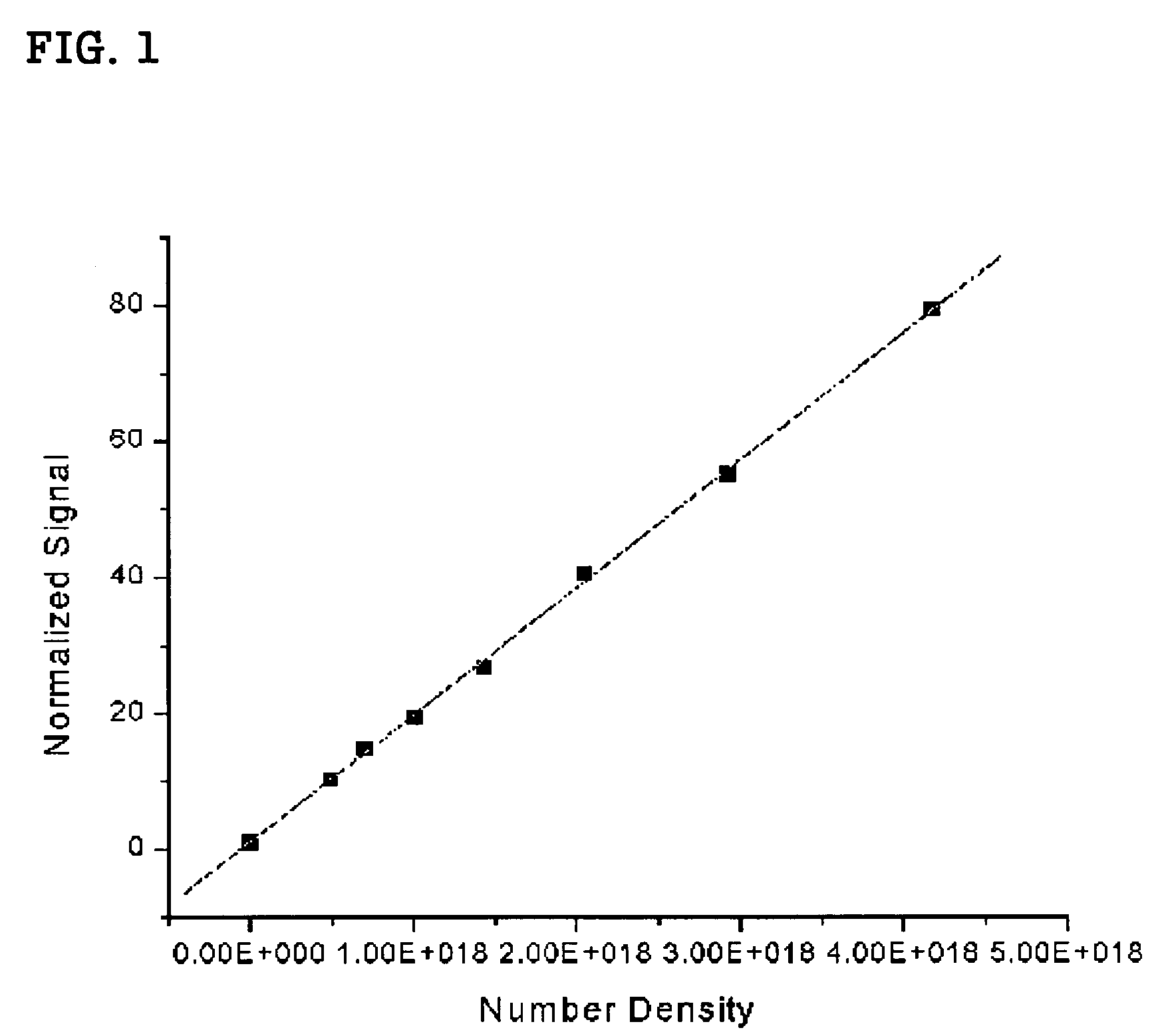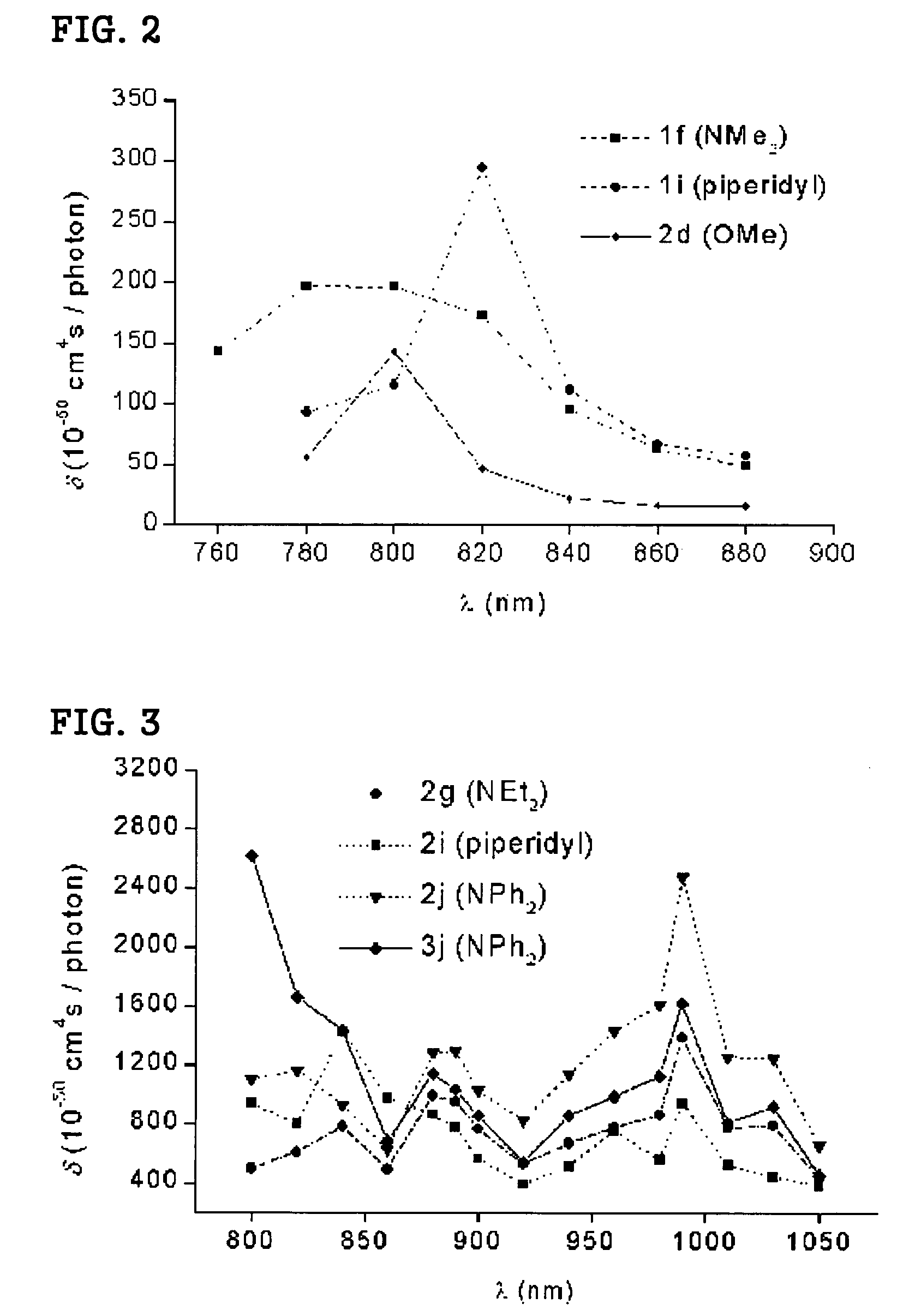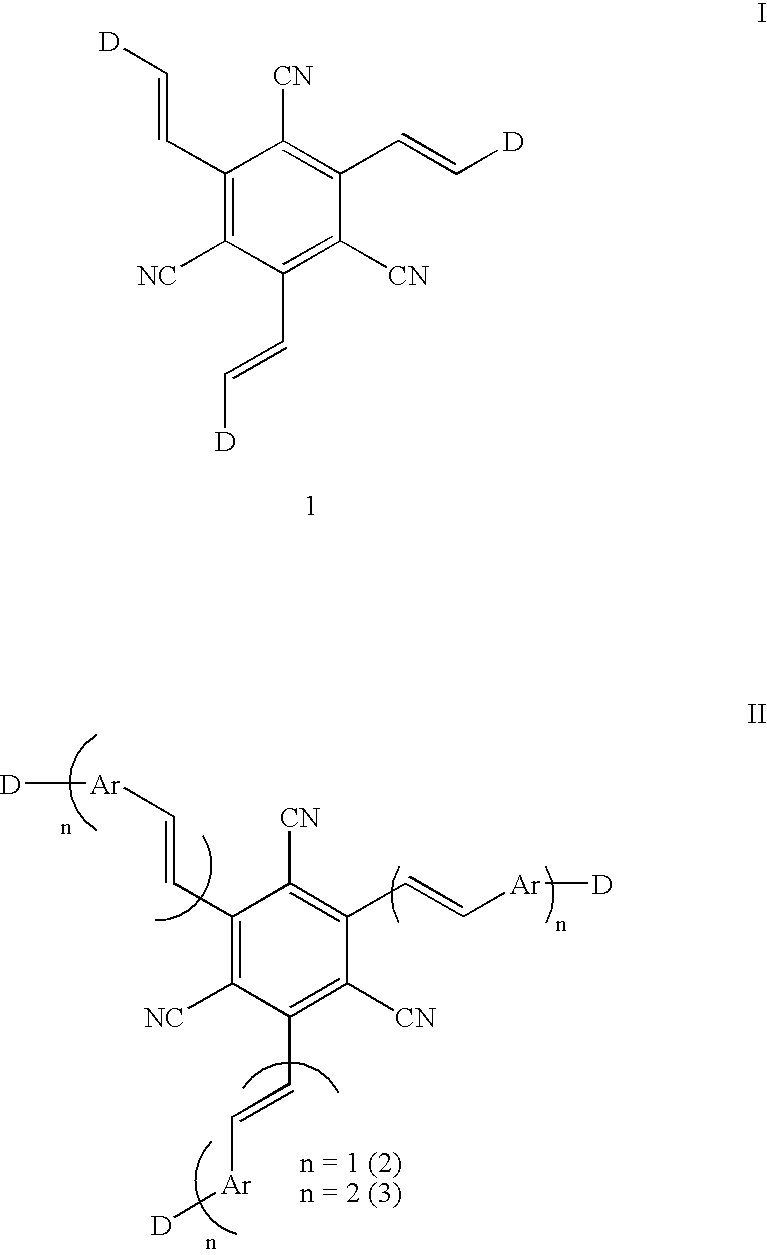1,3,5-tricyano-2,4,6-tris(vinyl)benzene derivatives and method for preparing the same
a technology of tricyano-2,4,6-tris(vinyl)benzene and derivatives, which is applied in the field of 1, 3, 5tricyano-2, 4, 6tris (vinyl)benzene derivatives and method for preparing the same. it can solve the problems of octupolar molecule, many technical problems in the process, and reduced nonlinear optical properties with tim
- Summary
- Abstract
- Description
- Claims
- Application Information
AI Technical Summary
Benefits of technology
Problems solved by technology
Method used
Image
Examples
example 1
Synthesis of 1,3,5-tricyano-2,4,6-tris(2-dialkylaminovinyl)benzene
[0040]A solution of 1,3,5-tricyanomesitylene (0.50 g, 2.6 mmol) and N,N-dimethylformamide diethylacetal (1.0 g, 8.5 mmol) in 2 mL of DMF was refluxed for 12 hrs. The product was filtered, washed with ether, and recrystallized in MeOH-CH2Cl2. Compound 1b was prepared by the same procedure except that dimethylacetal of N-formylpiperidine was used. The yield (%), melting point (° C.), IR (KBr, cm−1), 1H NMR (300 MHz, CDCl3), CMR (75 MHz, CDCl3), and combustion analysis data for 1a-b are as follows. Chemical shifts are in ppm and J values in Hz.
[0041](i) 1,3,5-Tricyano-2,4,6-tris(2-dimethylaminovinyl)benzene (1f)
[0042]Yield 92%; mp 252° C. subl; IR 2192 (CN), 1610 (C═C); 1H NMR δ 7.73 (d, 3H, J=13.2), 5.30 (d, 3H, J=13.2), 2.99 (s, 18H). CMR δ 150.9, 148.5, 120.3, 95.4, 91.6, 40.8. Anal. Calcd for C21H24N6: C, 69.97; H, 6.71; N, 23.32. Found: C, 69.95; H, 6.69; N, 23.25.
[0043](ii) 1,3,5-Tricyano-2,4,6-tris(2-piperidin-1-y...
example 2
Synthesis of 1,3,5-tricyano-2,4,6tris(styryl)benzene and 1,3,5-tricyano-2,4,6tris[4-(aminostyryl)]benzene
[0045](1) Synthesis of 1,3,5-Tricyano-2,4,6-tris(bromomethyl)benzene
[0046]A solution of 1,3,5-tricyanomesitylene (6.0 g, 31 mmol) and Br2 (17.2 g, 108 mmol) in 250 mL of CCl4 was irradiated with 400 W tungsten lamp for 2 hrs. After removing the excess Br2 with Na2S2O3 (aq), the product was extracted with CH2Cl2, and purified by column chromatography with hexane / ethyl acetate (10 / 1) to obtain 1,3,5-tricyano-2,4,6-tris(bromomethyl)benzene as white solid. Yield, 12.6 g (95%); mp 120° C.; IR 2229 (CN); 1H NMR δ 4.80 (s, 6H).
[0047](2) Synthesis of 1,3,5-Tricyano-2,4,6-tris[(diethoxyphosphoryl)methyl]benzene
[0048]A solution of 1,3,5-tricyano-2,4,6-tris(bromomethyl)benzene (1.0 g, 2.3 mmol) and P(OEt)3 (1.6 g, 14 mmol) in 60 mL of toluene was refluxed for 4 hrs. The solvent was removed in vacuo and the product was purified by column chromatography with hexane / ethyl acetate (10 / 1) as the...
example 3
Nonlinear Optical Property(β) and Thermal Stability of 1,3,5-tricyano-2,4,6-tris(vinyl)benzene derivatives
[0065]The β values of the 1,3,5-tricyano-2,4,6-tris(vinyl)benzene derivatives 1-3 were measured at 1560 nm by Hyper-Rayleigh Scattering (HRS) method (Acc. Chem. Res. 1998, 103, 4992). The intensity of second-harmonic radiation, which is generated when the solution of nonlinear optical materials in CHCl3 is irritated, is described by the following expression.
I2ω(solution)=K(Nss2>+Ncc2>)Iω2 (1)[0066]wherein, Ns and Nc represent the concentration of solvent and chromophore, respectively; 2> is the orientational average of the first hyperpolarizability; Iωand I2ωare the intensities of incident and scattered second-harmonic radiation. K indicates the number of scattered photons captured, which depends on experimental geometry, and thus is approximately constant for a given experimental condition. The first term in equation (1), K(Nss2>Iω2, is the second-harmonic scattering from ...
PUM
| Property | Measurement | Unit |
|---|---|---|
| electric field | aaaaa | aaaaa |
| nonlinear optical property | aaaaa | aaaaa |
| thermal stability | aaaaa | aaaaa |
Abstract
Description
Claims
Application Information
 Login to View More
Login to View More - R&D
- Intellectual Property
- Life Sciences
- Materials
- Tech Scout
- Unparalleled Data Quality
- Higher Quality Content
- 60% Fewer Hallucinations
Browse by: Latest US Patents, China's latest patents, Technical Efficacy Thesaurus, Application Domain, Technology Topic, Popular Technical Reports.
© 2025 PatSnap. All rights reserved.Legal|Privacy policy|Modern Slavery Act Transparency Statement|Sitemap|About US| Contact US: help@patsnap.com



